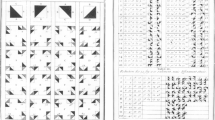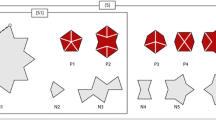Abstract
This research employs shape grammars to generate variations of the Truchet tile to characterize a two-dimensional and three-dimensional generative tiling system.
Similar content being viewed by others
Explore related subjects
Discover the latest articles, news and stories from top researchers in related subjects.Avoid common mistakes on your manuscript.
Introduction
In 1704, Sebastien Truchet published a short paper “Mémoire sur les Combinaisons” in which he examined the feasible patterns from a set of square tiles, each split diagonally into two colored triangles (Truchet 1704; Reimann 2009) (Fig. 1). He studied the “graphical treatment of combinatorics”, which was largely revolutionary in mathematics at the time (Smith and Boucher 1987). In 1987, C.S. Smith published “The Tiling Patterns of Sebastien Truchet and the Topology of Structural Hierarchy”, in which he analyzed Truchet’s tiling pattern and introduced the now recognized variation of Truchet’s original tile (Smith and Boucher 1987). In this variation, Smith used arcs in diagonal corners, replacing the two triangles of Truchet’s original tile. Each quarter-circle arc bisects the square tile edge at its midpoint, so that when the tiles are arranged adjacently the arcs meet to form a set of connected arcs (Fig. 2). The rotational quality of the tiles allows for a multiplicity of tiling arrangements. This research utilizes Smith’s variation of Truchet’s tile, henceforth known as the Truchet Tile, as the basis of a Truchet Tile Grammar.
Sebastian Truchet’s original tile: a Truchet’s bi-colored tiles, b Possible combinations of two tiles, c Example tiling pattern. Tiles redrawn from (Smith and Boucher 1987)
C.S. Smith’s “Truchet Tile”: (a) Truchet Tiles, b Possible combinations of two tiles, c Example tiling pattern. Tiles redrawn from (Smith and Boucher 1987)
Research
The “Graphical Treatment of Combinatorics” and Shape Grammars
Truchet’s desire to explore the visual aspects of combinatorial problems was inspired by observing a pile of ceramic tiles with a diagonal division and imagining how a variety of visually pleasing floor patterns could be achieved with a single tile. Smith notes that while all the relationships Truchet calculated in his treatise could be represented by simple combinatorial mathematics, the visual display was more meaningful to many people and captured some of the rules artists use “whether or not they are aware of them” (Smith and Boucher 1987). Truchet’s interest in using a visual representation to calculate possible tile arrangements and then to subsequently use those spatial relationships as the basis for the generation of a family of tiling patterns shares much with the ambitions of the shape grammar discourse. This research takes on that shared interest to study how shape grammars can formalize and expand our understanding of Truchet tiles and their possible applications in design. Building on Smith’s topological study of the Truchet tile (Smith and Boucher 1987), the design of additional variations of Truchet tiles is pursued here using shape rules.
Shape rules are the fundamental building blocks of shape grammars, one of the most powerful formalisms for the generative description of designs (Stiny and Gips 1972; Stiny 1980a, 2006; Knight 1994). Shape rules are written using the general form A → B, where the shape A, sometimes embedded within the design context where the rule is applied, is replaced with the shape B. A shape grammar is a set of such shape rules applied consecutively to generate designs, and the visual computations described in shape rules operate directly with points, lines, planes, and/or volumes. The ice-ray grammar by Stiny (1977: 89–98) demonstrates how shape grammars have been applied to study the parametric structure of ornamental lattice designs as well as simpler patterns with observable periodic or regular structure, which are comparable to the studies in Truchet’s treatise. The key design operation for both Stiny’s simple lattice patterns and Truchet’s combinatorial tiling system is the orientation of a single motif and/or a single tile, suggesting a starting point for translating Truchet’s logic into a rule-based specification. This research takes on this effort by employing shape grammars to generate variations of the Truchet tile to characterize a two-dimensional and three-dimensional generative tiling system. Note that in this grammar, shapes do not fuse and are instead defined as “set grammars”, such as the grammar defined by Stiny for physical play with Kindergarten blocks (Stiny 1980b).
The Truchet Tile Grammar
The Truchet Tile Grammar consists of three rule sets: (1) Two-Dimensional Tile Rules, (2) Two-Dimensional Pattern Rules, and (3) Three-Dimensional Tile Rules. These rule sets can be employed independently or in a consecutive order depending on the design intent.
Two-Dimensional Tile Rules
The first set of shape rules are used to generate two-dimensional tiles rooted in the logic of the Truchet Tile. Although Smith’s original Truchet Tile is exclusively based on squares, the generic rules in the Truchet Tile Grammar expand the Truchet tiling logic to include other regular and irregular polygons that can tile a plane and introduce more tiling variations. The grammar begins with an initial shape rule to place labels on a polygon in the cartesian plane. Shape rules consisting of sum operations and general transformations are then applied recursively. Each tile generated is a closed shape with arcs in diagonal corners; the degree of the arc is controlled by parametric variables (centroid: \(({x}_{0},{y}_{0})\); radius: \({r}_{0}\)). Color fields are used as weights (Knight 1989; Stiny 1992) to differentiate specific areas of the tiles, a convention used in this stage to generate a pair of inverse tiles with complementary color fields. These weights are subsequently used to inform the parameters of three-dimensional tile rules later in the grammar. Figure 3 depicts a sample derivation using the rules to generate two-dimensional square Truchet tiles.
Two-Dimensional Pattern Rules
The two-dimensional pattern rules are used to create basic tiling configurations and then to place specific tile motifs within a basic pattern. Based on the nature of the Truchet Tile, the shape rules make use of rotation and reflection while generating the two-dimensional tiling configurations. These rules similarly make use of weights and labels to specify the orientations and to distinguish between the two pairs of tiles generated with the previous rule set. The two-dimensional pattern rules can be defined by the schemas \(x \to x + t\left( x \right)\) and \(x \to x + t\left( {x^{\prime } } \right)\) , in which a translated version of a tile or a translated and inverted version of a tile is copied adjacently to that tile. Figure 4 shows six two-dimensional patterns that are generated using the same two-dimensional tiling configuration (shown on the left) with different square Truchet tiles generated using the two-dimensional tile rules from the previous rule set.
Three-Dimensional Tile Rules
Three-dimensional tile rules transform the two-dimensional tiles into three dimensional tiles in various ways. Parametric shape rules are used to control the depth of different regions of the individual tiles, which were previously specified with the color weights assigned. The resulting three-dimensional tiles can be assembled together with varying patterns and depths to generate three-dimensional patterns. Figure 5 shows six three-dimensional patterns based on the two-dimensional tiling configurations exemplified in Fig. 4. The tiles shown here are generated using rules that transform the two-dimensional tiles into three-dimensional tiles through extrusion.
Conclusions and Discussion
The Truchet Tile Grammar presented in this paper is a generative system for designing two-dimensional and three-dimensional tiles and patterns. In his “graphical treatment of combinatorics,” Truchet defined visual relations for combining two-dimensional tiles to generate various abstract patterns (Smith and Boucher 1987). The Truchet Tile Grammar outlined in this paper builds on Truchet’s visual notations while defining the two-dimensional pattern rules, but also expands it to include more variations in terms of tile geometry, shape, and three-dimensionality. Figure 6 exemplifies some of the two-dimensional and three-dimensional tiles, as well as patterns that can be generated using the grammar. Note that the derivations are not limited to these examples. The grammar provides an open-ended framework to generate two-dimensional and three-dimensional tiles and patterns.
The Truchet Tile Grammar can be useful for various design scenarios. The grammar can be used for designing and manufacturing floor tiles and wall panels, such as the acoustic panels by Worre Foged and Scaffidi (2022: 101–110), that can generate visually interesting and customizable patterns with only a small subset of unique components. On the other hand, the use of the Truchet Tile Grammar is not limited to designing architectural tiles and panels. As Lionel March (2015: 553–578) has discussed in “Mathematics and Architecture since 1960”, these kinds of formalisms can also be used in urban planning and spatial design. The recent conceptual Tile House project by Matsys, for instance, makes use of Truchet tile logic in the generation of plan layouts.
During the conference, we aim to provide a background on Truchet tiling, present in detail the Truchet Tile Grammar and how we translated Truchet’s visual notations for “combinatorics” as shape rules, exemplify potential use cases and discuss its limitations.
Data availability
The complete Truchet Tile Grammar rule sets are available from The Pennsylvania State University Libraries, but restrictions apply to the availability of these data. The data are, however, available from the authors upon request.
References
Knight, Terry W. (1989). Color Grammars: Designing with Lines and Colors. Environment and Planning B: Planning and Design, 16(4), 417-449. https://doi.org/10.1068/b160417
Knight, Terry W. (1994). Transformations in Design: A Formal Approach to Stylistic Change and Innovation in the Visual Arts. Cambridge ; New York: Cambridge University Press.
March, Lionel. (2015). Mathematics and architecture since 1960. In Architecture and Mathematics from antiquity to the future volume II, eds. K. Williams and M.J. Ostwald, 553–578. Birkhäuser.
Reimann, David A. (2009). Text from Truchet Tiles. In: Bridges Conference Proceedings, Banff, Canada, p. 325–326
Smith, Cyril Stanley, & Boucher, Pauline. (1987). The Tiling Patterns of Sebastien Truchet and the Topology of Structural Hierarchy. Leonardo, 20(4), 373-385.
Stiny, George. (1977). Ice-Ray: A Note on the Generation of Chinese Lattice Designs. Environment and Planning B: Planning and Design, 4(1), 89-98. https://doi.org/10.1068/b040089
Stiny, G 1980a Introduction to shape and shape grammars Environment and Planning b: Planning and Design 7 3 343 351 https://doi.org/10.1068/b070343
Stiny, G. (1980b). Kindergarten grammars: designing with Froebel’s building gifts. Environment and Planning B, 7(4), 409-462
Stiny, George. (1992). Weights. Environment and Planning B: Planning and Design, 19(4), 371-488
Stiny, George. (2006). Shape: Talking About Seeing and Doing. Cambridge, MA: MIT Press.
Stiny, George and Gips, James (1972). Shape Grammars and the Generative Specification of Painting and Sculpture. Paper presented at the Information Processing 71, Amsterdam: North-Holland
Truchet, Sebastian (1704) Mémoire sur les Combinaisons. Mémoires de l’Académie Royale des Sciences, 363–372
Worre Foged, Isak, & Scaffidi, Antonio. (2022). A Design and Fabrication Method for Hemp Based Acoustic Elements. In: Co-creating the Future: Inclusion in and through Design: Proceedings of the 40th Conference on Education and Research in Computer Aided Architectural Design in Europe 1: 101–110.
Author information
Authors and Affiliations
Corresponding author
Ethics declarations
Conflict of Interest
On behalf of all authors, the corresponding author states that there is no conflict of interest.
Additional information
Publisher's Note
Springer Nature remains neutral with regard to jurisdictional claims in published maps and institutional affiliations.
About this article
Cite this article
Walter, N., Ligler, H. & Gürsoy, B. From Graphical Treatment of Combinatorics to Tiling Grammars. Nexus Netw J 25 (Suppl 1), 321–332 (2023). https://doi.org/10.1007/s00004-023-00715-2
Accepted:
Published:
Issue Date:
DOI: https://doi.org/10.1007/s00004-023-00715-2










